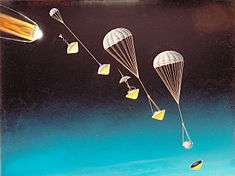
Galileo Probe
The Galileo Probe was an atmospheric-entry probe carried by the main Galileo spacecraft to Jupiter, where it directly entered and returned data from the planet. The 339-kilogram (747 lb) probe was built by Hughes Aircraft Company at its El Segundo, California plant, measured about 1.3 meters (4.3 ft) across. Inside the probe's heat shield, the scientific instruments were protected from extreme heat and pressure during its high-speed journey into the Jovian atmosphere, travelling at 47.8 kilometers (29.7 mi) per second.
Mission
The probe was released from the main spacecraft in July 1995, five months before reaching Jupiter, and entered Jupiter's atmosphere with no braking beforehand. The probe was slowed from its arrival speed of about 47 kilometers per second to subsonic speed in less than two minutes. The air friction heated the heat shield to around 15,500 °C (27,932 °F).
At the time, this was by far the most difficult atmospheric entry ever attempted; the probe had to withstand 230 g and the probe's 152 kg heat shield, making up almost half of the probe's total mass, lost 80 kg during the entry. NASA built a special laboratory, the Giant Planet Facility, to simulate the heat load, which was similar to the convective heating experienced by an ICBM warhead reentering the atmosphere combined with the radiative heating of a thermonuclear fireball. It then deployed its 2.5-meter (8.2-foot) parachute, and dropped its heat shield, which fell into Jupiter's interior.

Galileo (spacecraft)
Galileo was an unmanned spacecraft that studied the planet Jupiter and its moons, as well as several other Solar System bodies. Named after the astronomer Galileo Galilei, it consisted of an orbiter and entry probe. It was launched on October 18, 1989, carried by Space Shuttle Atlantis, on the STS-34 mission. Galileo arrived at Jupiter on December 7, 1995, after gravitational assist flybys of Venus and Earth, and became the first spacecraft to orbit Jupiter. It launched the first probe into Jupiter, directly measuring its atmosphere. Despite suffering major antenna problems, Galileo achieved the first asteroid flyby, of 951 Gaspra, and discovered the first asteroid moon, Dactyl, around 243 Ida. In 1994, Galileo observed Comet Shoemaker–Levy 9's collision with Jupiter. The spacecraft was an international effort by the United States of America and the Federal Republic of Germany.
Jupiter's atmospheric composition and ammonia clouds were recorded, the clouds possibly created by outflows from the lower depths of the atmosphere. Io's volcanism and plasma interactions with Jupiter's atmosphere were also recorded. The data Galileo collected supported the theory of a liquid ocean under the icy surface of Europa, and there were indications of similar liquid-saltwater layers under the surfaces of Ganymede and Callisto. Ganymede was shown to possess a magnetic field and the spacecraft found new evidence for exospheres around Europa, Ganymede, and Callisto.Galileo also discovered that Jupiter's faint ring system consists of dust from impacts on the four small inner moons. The extent and structure of Jupiter's magnetosphere was also mapped.
Podcasts:

